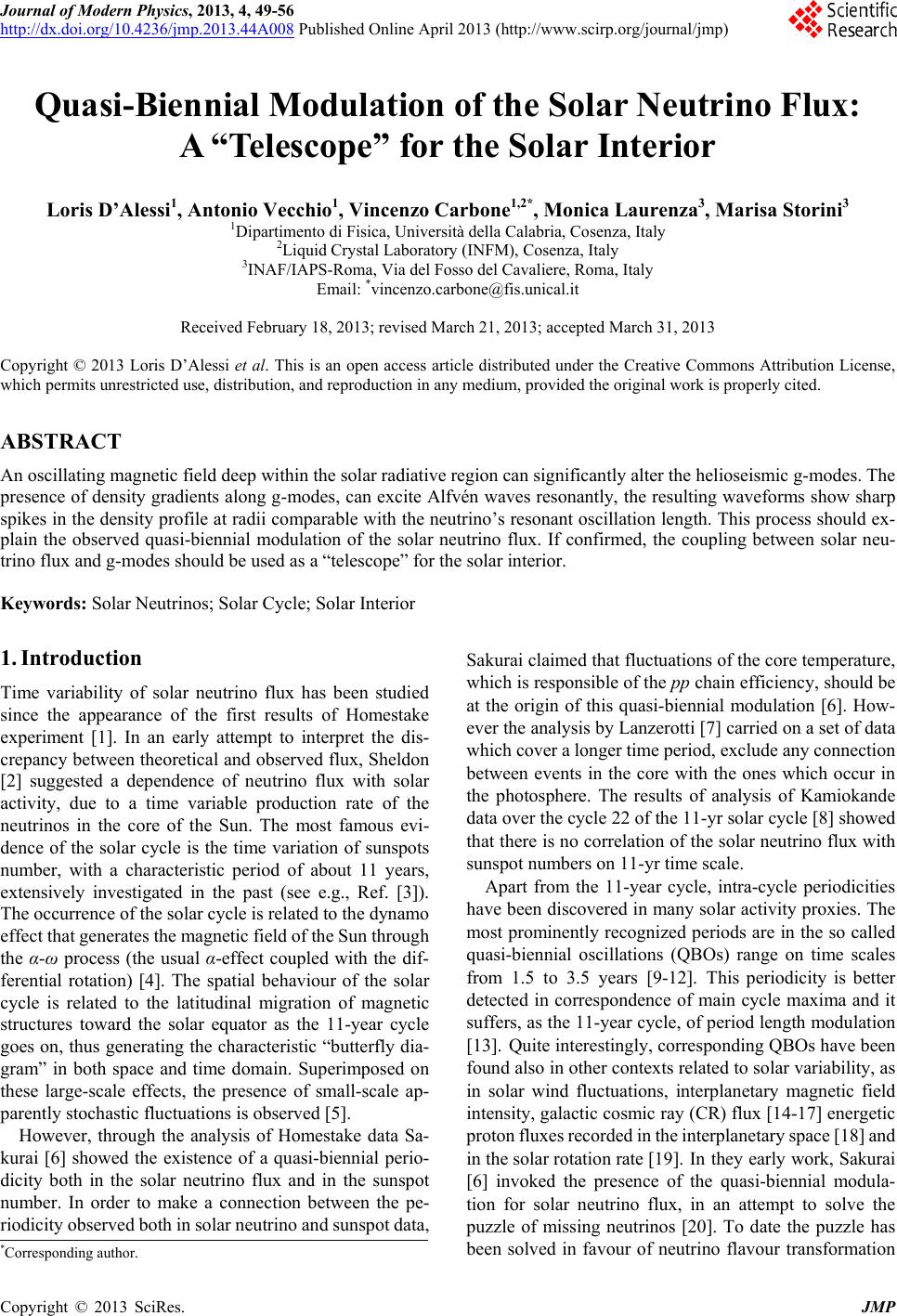 Journal of Modern Physics, 2013, 4, 49-56 http://dx.doi.org/10.4236/jmp.2013.44A008 Published Online April 2013 (http://www.scirp.org/journal/jmp) Quasi-Biennial Modulation of the Solar Neutrino Flux: A “Telescope” for the Solar Interior Loris D’Alessi1, Antonio Vecchio1, Vincenzo Carbone1,2*, Monica Laurenza3, Marisa Storini3 1Dipartimento di Fisica, Università della Calabria, Cosenza, Italy 2Liquid Crystal Laboratory (INFM), Cosenza, Italy 3INAF/IAPS-Roma, Via del Fosso del Cavaliere, Roma, Italy Email: *vincenzo.carbone@fis.unical.it Received February 18, 2013; revised March 21, 2013; accepted March 31, 2013 Copyright © 2013 Loris D’Alessi et al. This is an open access article distributed under the Creative Commons Attribution License, which permits unrestricted use, distribution, and reproduction in any medium, provided the original work is properly cited. ABSTRACT An oscillating magnetic field deep within the solar radiative region can significantly alter the helioseismic g-modes. The presence of density gradients along g-modes, can excite Alfvén waves resonantly, the resulting waveforms show sharp spikes in the density profile at radii comparable with the neutrino’s resonant oscillation length. This process should ex- plain the observed quasi-biennial modulation of the solar neutrino flux. If confirmed, the coupling between solar neu- trino flux and g-modes should be used as a “telescope” for the solar interior. Keywords: Solar Neutrinos; Solar Cycle; Solar Interior 1. Introduction Sakurai claimed that fluctuations of the core temperature, which is responsible of the pp chain efficiency, should be at the origin of this quasi-biennial modulation [6]. How- ever the analysis by Lanzerotti [7] carried on a set of data which cover a longer time period, exclude any connection between events in the core with the ones which occur in the photosphere. The results of analysis of Kamiokande data over the cycle 22 of the 11-yr solar cycle [8] showed that there is no correlation of the solar neutrino flux with sunspot numbers on 11-yr time scale. Time variability of solar neutrino flux has been studied since the appearance of the first results of Homestake experiment [1]. In an early attempt to interpret the dis- crepancy between theoretical and observed flux, Sheldon [2] suggested a dependence of neutrino flux with solar activity, due to a time variable production rate of the neutrinos in the core of the Sun. The most famous evi- dence of the solar cycle is the time variation of sunspots number, with a characteristic period of about 11 years, extensively investigated in the past (see e.g., Ref. [3]). The occurrence of the solar cycle is related to the dynamo effect that generates the magnetic field of the Sun through the α-ω process (the usual α-effect coupled with the dif- ferential rotation) [4]. The spatial behaviour of the solar cycle is related to the latitudinal migration of magnetic structures toward the solar equator as the 11-year cycle goes on, thus generating the characteristic “butterfly dia- gram” in both space and time domain. Superimposed on these large-scale effects, the presence of small-scale ap- parently stochastic fluctuations is observed [5]. Apart from the 11-year cycle, intra-cycle periodicities have been discovered in many solar activity proxies. The most prominently recognized periods are in the so called quasi-biennial oscillations (QBOs) range on time scales from 1.5 to 3.5 years [9-12]. This periodicity is better detected in correspondence of main cycle maxima and it suffers, as the 11-year cycle, of period length modulation [13]. Quite interestingly, corresponding QBOs have been found also in other contexts related to solar variability, as in solar wind fluctuations, interplanetary magnetic field intensity, galactic cosmic ray (CR) flux [14-17] energetic proton fluxes recorded in the interplanetary space [18] and in the solar rotation rate [19]. In they early work, Sakurai [6] invoked the presence of the quasi-biennial modula- tion for solar neutrino flux, in an attempt to solve the puzzle of missing neutrinos [20]. To date the puzzle has been solved in favour of neutrino flavour transformation However, through the analysis of Homestake data Sa- kurai [6] showed the existence of a quasi-biennial perio- dicity both in the solar neutrino flux and in the sunspot number. In order to make a connection between the pe- riodicity observed both in solar neutrino and sunspot data, *Corresponding author. C opyright © 2013 SciRes. JMP 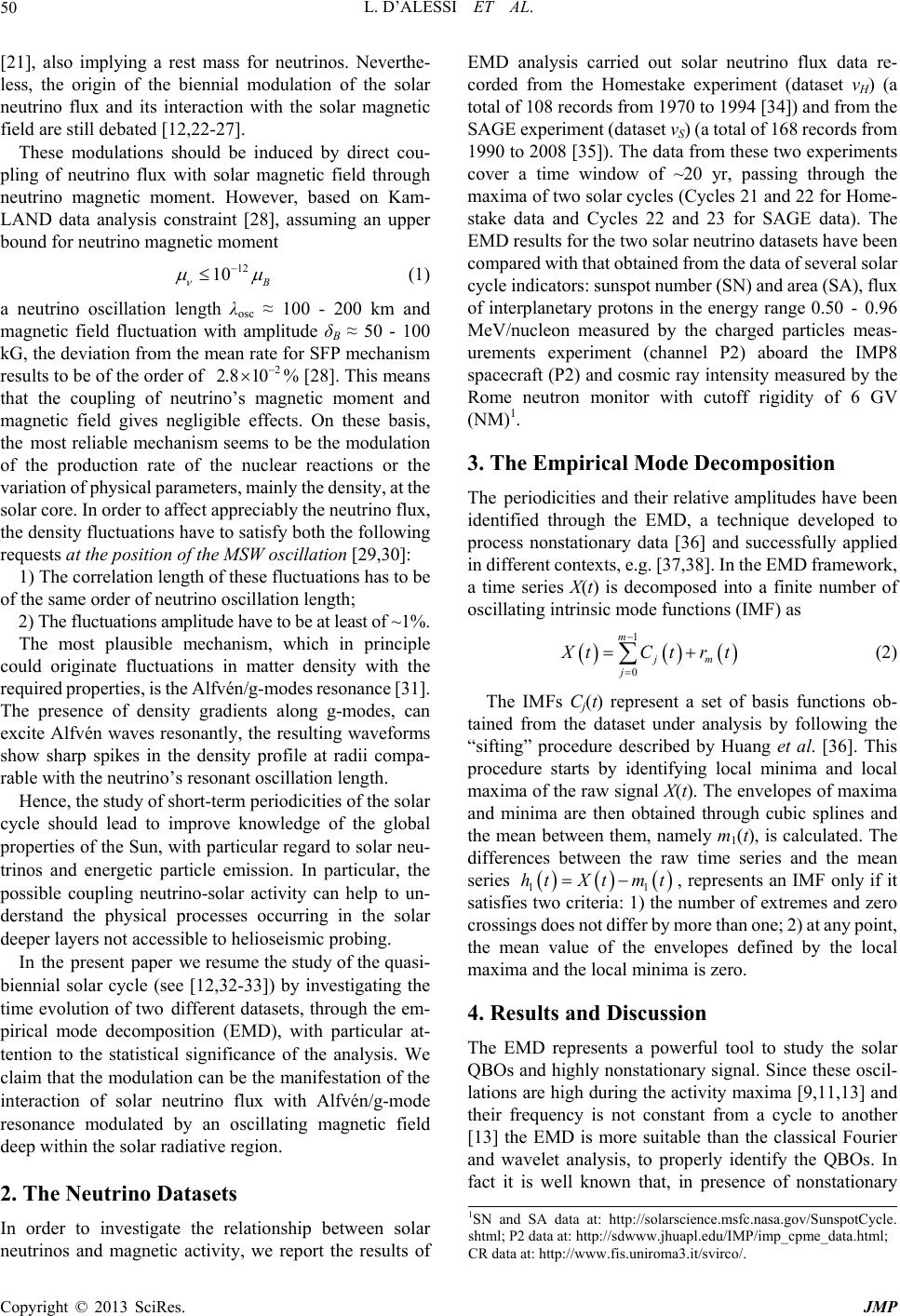 L. D’ALESSI ET AL. 50 [21], also implying a rest mass for neutrinos. Neverthe- less, the origin of the biennial modulation of the solar neutrino flux and its interaction with the solar magnetic field are still debated [12,22-27]. These modulations should be induced by direct cou- pling of neutrino flux with solar magnetic field through neutrino magnetic moment. However, based on Kam- LAND data analysis constraint [28], assuming an upper bound for neutrino magnetic moment 12 10 2 2.810 1 0 m jm j (1) a neutrino oscillation length λosc ≈ 100 - 200 km and magnetic field fluctuation with amplitude δB ≈ 50 - 100 kG, the deviation from the mean rate for SFP mechanism results to be of the order of % [28]. This means that the coupling of neutrino’s magnetic moment and magnetic field gives negligible effects. On these basis, the most reliable mechanism seems to be the modulation of the production rate of the nuclear reactions or the variation of physical parameters, mainly the density, at the solar core. In order to affect appreciably the neutrino flux, the density fluctuations have to satisfy both the following requests at the position of the MSW oscillation [29,30]: 1) The correlation length of these fluctuations has to be of the same order of neutrino oscillation length; 2) The fluctuations amplitude have to be at least of ~1%. The most plausible mechanism, which in principle could originate fluctuations in matter density with the required properties, is the Alfvén/g-modes resonance [31]. The presence of density gradients along g-modes, can excite Alfvén waves resonantly, the resulting waveforms show sharp spikes in the density profile at radii compa- rable with the neutrino’s resonant oscillation length. Hence, the study of short-term periodicities of the solar cycle should lead to improve knowledge of the global properties of the Sun, with particular regard to solar neu- trinos and energetic particle emission. In particular, the possible coupling neutrino-solar activity can help to un- derstand the physical processes occurring in the solar deeper layers not accessible to helioseismic probing. In the present paper we resume the study of the quasi- biennial solar cycle (see [12,32-33]) by investigating the time evolution of two different datasets, through the em- pirical mode decomposition (EMD), with particular at- tention to the statistical significance of the analysis. We claim that the modulation can be the manifestation of the interaction of solar neutrino flux with Alfvén/g-mode resonance modulated by an oscillating magnetic field deep within the solar radiative region. 2. The Neutrino Datasets In order to investigate the relationship between solar neutrinos and magnetic activity, we report the results of EMD analysis carried out solar neutrino flux data re- corded from the Homestake experiment (dataset νH) (a total of 108 records from 1970 to 1994 [34]) and from the SAGE experiment (dataset νS) (a total of 168 records from 1990 to 2008 [35]). The data from these two experiments cover a time window of ~20 yr, passing through the maxima of two solar cycles (Cycles 21 and 22 for Home- stake data and Cycles 22 and 23 for SAGE data). The EMD results for the two solar neutrino datasets have been compared with that obtained from the data of several solar cycle indicators: sunspot number (SN) and area (SA), flux of interplanetary protons in the energy range 0.50 - 0.96 MeV/nucleon measured by the charged particles meas- urements experiment (channel P2) aboard the IMP8 spacecraft (P2) and cosmic ray intensity measured by the Rome neutron monitor with cutoff rigidity of 6 GV (NM)1. 3. The Empirical Mode Decomposition The periodicities and their relative amplitudes have been identified through the EMD, a technique developed to process nonstationary data [36] and successfully applied in different contexts, e.g. [37,38]. In the EMD framework, a time series X(t) is decomposed into a finite number of oscillating intrinsic mode functions (IMF) as tCtrt (2) The IMFs Cj(t) represent a set of basis functions ob- tained from the dataset under analysis by following the “sifting” procedure described by Huang et al. [36]. This procedure starts by identifying local minima and local maxima of the raw signal X(t). The envelopes of maxima and minima are then obtained through cubic splines and the mean between them, namely m1(t), is calculated. The differences between the raw time series and the mean series htXt mt 11 , represents an IMF only if it satisfies two criteria: 1) the number of extremes and zero crossings does not differ by more than one; 2) at any point, the mean value of the envelopes defined by the local maxima and the local minima is zero. 4. Results and Discussion The EMD represents a powerful tool to study the solar QBOs and highly nonstationary signal. Since these oscil- lations are high during the activity maxima [9,11,13] and their frequency is not constant from a cycle to another [13] the EMD is more suitable than the classical Fourier and wavelet analysis, to properly identify the QBOs. In fact it is well known that, in presence of nonstationary 1SN and SA data at: http://solarscience.msfc.nasa.gov/SunspotCycle. shtml; P2 data at: http://sdwww.jhuapl.edu/IMP/imp_cpme_data.html; CR data at: http://www.fis.uniroma3.it/svirco/. Copyright © 2013 SciRes. JMP 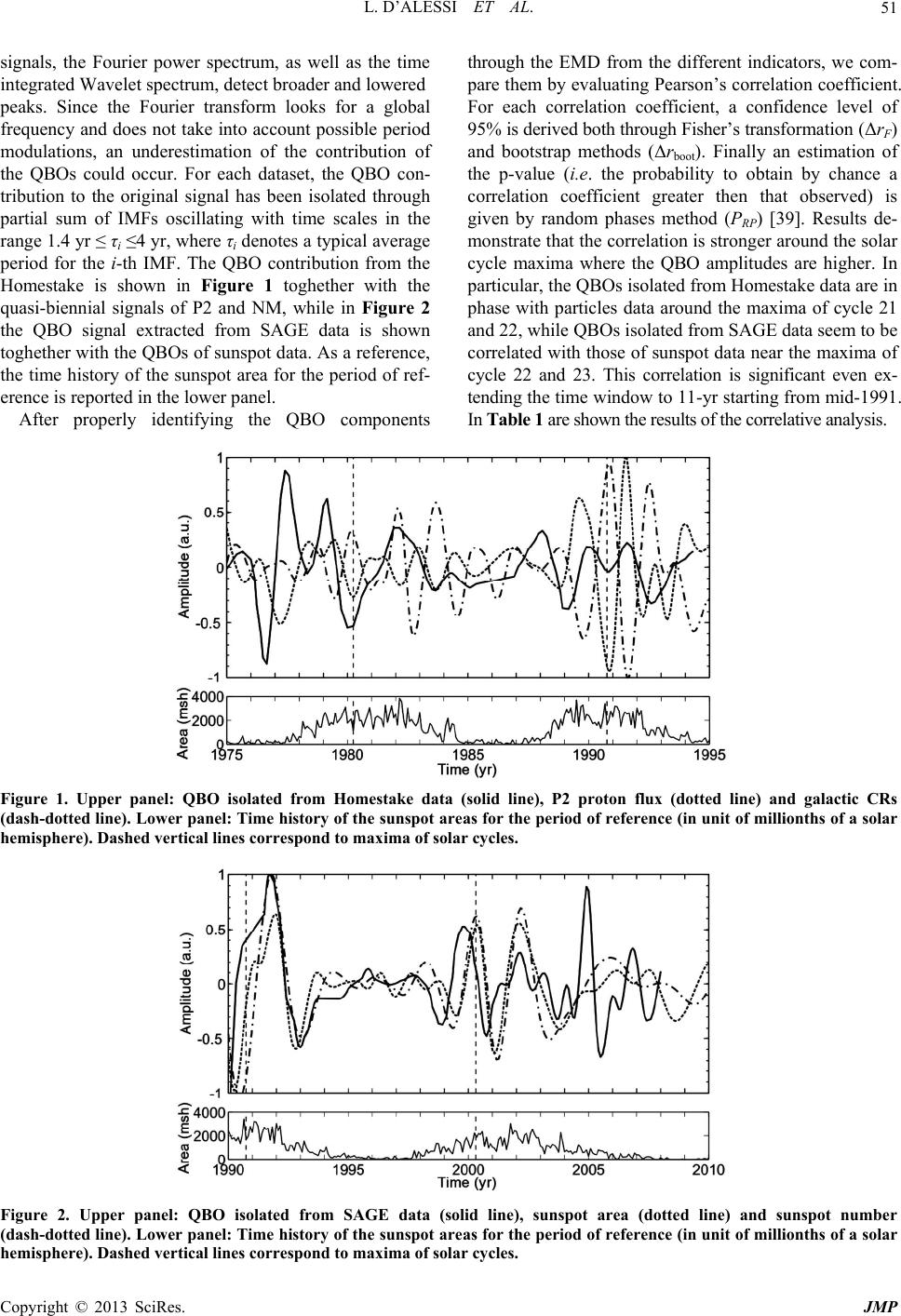 L. D’ALESSI ET AL. CopyrigJMP 51 signals, the Fourier power spectrum, as well as the time integrated Wavelet spectrum, detect broader and lowered peaks. Since the Fourier transform looks for a global frequency and does not take into account possible period modulations, an underestimation of the contribution of the QBOs could occur. For each dataset, the QBO con- tribution to the original signal has been isolated through partial sum of IMFs oscillating with time scales in the range 1.4 yr ≤ τi ≤4 yr, where τi denotes a typical average period for the i-th IMF. The QBO contribution from the Homestake is shown in Figure 1 toghether with the quasi-biennial signals of P2 and NM, while in Figure 2 the QBO signal extracted from SAGE data is shown toghether with the QBOs of sunspot data. As a reference, the time history of the sunspot area for the period of ref- erence is reported in the lower panel. After properly identifying the QBO components through the EMD from the different indicators, we com- pare them by evaluating Pearson’s correlation coefficient. For each correlation coefficient, a confidence level of 95% is derived both through Fisher’s transformation (ΔrF) and bootstrap methods (Δrboot). Finally an estimation of the p-value (i.e. the probability to obtain by chance a correlation coefficient greater then that observed) is given by random phases method (PRP) [39]. Results de- monstrate that the correlation is stronger around the solar cycle maxima where the QBO amplitudes are higher. In particular, the QBOs isolated from Homestake data are in phase with particles data around the maxima of cycle 21 and 22, while QBOs isolated from SAGE data seem to be correlated with those of sunspot data near the maxima of cycle 22 and 23. This correlation is significant even ex- tending the time window to 11-yr starting from mid-1991. In Table 1 are shown the results of the correlative analysis. Figure 1. Upper panel: QBO isolated from Homestake data (solid line), P2 proton flux (dotted line) and galactic CRs (dash-dotted line). Lower panel: Time history of the sunspot areas for the period of reference (in unit of millionths of a solar hemisphere). Dashed vertical lines correspond to maxima of solar cycles. Figure 2. Upper panel: QBO isolated from SAGE data (solid line), sunspot area (dotted line) and sunspot number (dash-dotted line). Lower panel: Time history of the sunspot areas for the period of reference (in unit of millionths of a solar hemisphere). Dashed vertical lines correspond to maxima of solar cycles. ht © 2013 SciRes. 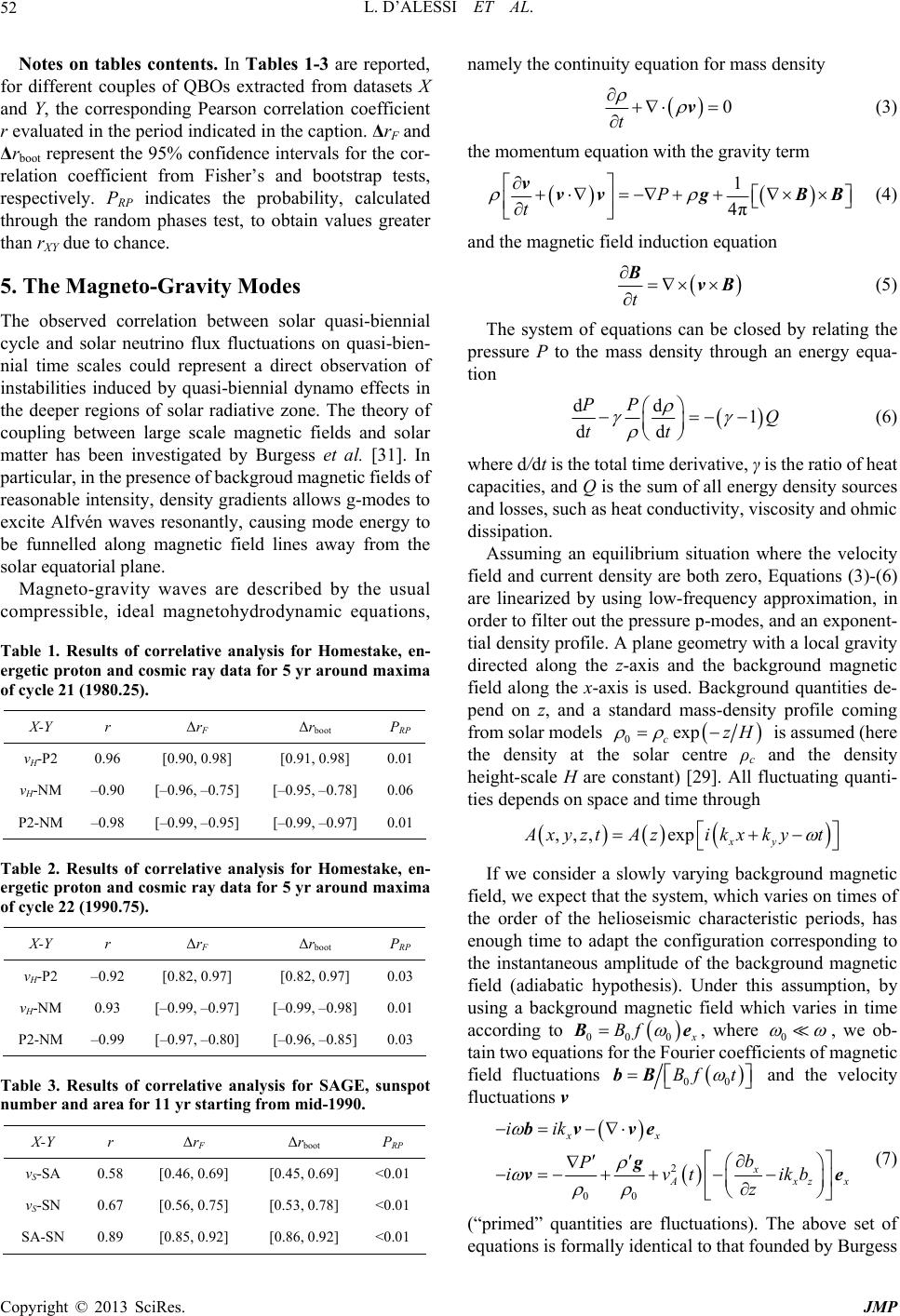 L. D’ALESSI ET AL. 52 Notes on tables contents. In Tables 1-3 are reported, for different couples of QBOs extracted from datasets X and Y, the corresponding Pearson correlation coefficient r evaluated in the period indicated in the caption. ΔrF and Δrboot represent the 95% confidence intervals for the cor- relation coefficient from Fisher’s and bootstrap tests, respectively. PRP indicates the probability, calculated through the random phases test, to obtain values greater than rXY due to chance. namely the continuity equation for mass density 5. The Magneto-Gravity Modes The observed correlation between solar quasi-biennial cycle and solar neutrino flux fluctuations on quasi-bien- nial time scales could represent a direct observation of instabilities induced by quasi-biennial dynamo effects in the deeper regions of solar radiative zone. The theory of coupling between large scale magnetic fields and solar matter has been investigated by Burgess et al. [31]. In particular, in the presence of backgroud magnetic fields of reasonable intensity, density gradients allows g-modes to excite Alfvén waves resonantly, causing mode energy to be funnelled along magnetic field lines away from the solar equatorial plane. Magneto-gravity waves are described by the usual compressible, ideal magnetohydrodynamic equations, Table 1. Results of correlative analysis for Homestake, en- ergetic proton and cosmic ray data for 5 yr around maxima of cycle 21 (1980.25). X-Y r ΔrF Δrboot PRP νH-P2 0.96 [0.90, 0.98] [0.91, 0.98] 0.01 νH-NM –0.90 [–0.96, –0.75] [–0.95, –0.78] 0.06 P2-NM –0.98 [–0.99, –0.95] [–0.99, –0.97] 0.01 Table 2. Results of correlative analysis for Homestake, en- ergetic proton and cosmic ray data for 5 yr around maxima of cycle 22 (1990.75). X-Y r ΔrF Δrboot PRP νH-P2 –0.92 [0.82, 0.97] [0.82, 0.97] 0.03 νH-NM 0.93 [–0.99, –0.97] [–0.99, –0.98] 0.01 P2-NM –0.99 [–0.97, –0.80] [–0.96, –0.85] 0.03 Table 3. Results of correlative analysis for SAGE, sunspot number and area for 11 yr starting from mid-1990. X-Y r ΔrF Δrboot PRP νS-SA 0.58 [0.46, 0.69] [0.45, 0.69] <0.01 νS-SN 0.67 [0.56, 0.75] [0.53, 0.78] <0.01 SA-SN 0.89 [0.85, 0.92] [0.86, 0.92] <0.01 0 t v (3) the momentum equation with the gravity term 1 4π P t vvvg BB (4) and the magnetic field induction equation t BvB (5) The system of equations can be closed by relating the pressure P to the mass density through an energy equa- tion dd 1 dd PP Q tt (6) where d/dt is the total time derivative, γ is the ratio of heat capacities, and Q is the sum of all energy density sources and losses, such as heat conductivity, viscosity and ohmic dissipation. Assuming an equilibrium situation where the velocity field and current density are both zero, Equations (3)-(6) are linearized by using low-frequency approximation, in order to filter out the pressure p-modes, and an exponent- tial density profile. A plane geometry with a local gravity directed along the z-axis and the background magnetic field along the x-axis is used. Background quantities de- pend on z, and a standard mass-density profile coming from solar models exp zH ,,,exp xy 0c is assumed (here the density at the solar centre ρc and the density height-scale H are constant) [29]. All fluctuating quanti- ties depends on space and time through xyztAzikx kyt If we consider a slowly varying background magnetic field, we expect that the system, which varies on times of the order of the helioseismic characteristic periods, has enough time to adapt the configuration corresponding to the instantaneous amplitude of the background magnetic field (adiabatic hypothesis). Under this assumption, by using a background magnetic field which varies in time according to 00 0 Bf Be, where 0 , we ob- tain two equations for the Fourier coefficients of magnetic field fluctuations 00 Bf t bB and the velocity fluctuations v 2 00 xx x Axzx iik b P ivtikb z bv ve g ve (7) (“primed” quantities are fluctuations). The above set of equations is formally identical to that founded by Burgess Copyright © 2013 SciRes. JMP  L. D’ALESSI ET AL. 53 et al. [31], apart for the fact that in our case 2 22 0 0 4π Bf t A vt is a time-dependent Alfvén speed. After some algebraic calculations we finally obtain an equation for the fluctuating magnetic field, whose solution determines all other fluctuating quantities 22 2 22 22 2 1d xA 2 2 22 dd d 10 z z N z bb xA kv t z N z kb 222 z kv t (8) where the perpendicular wave-vector is y kkk and we defined the Brunt-Väisälä frequency 2 Nz gz Pz 00 00 dd 11 dd P z 0B ,cosht (9) which represents the characteristic frequency of the sys- tem. Equation (8) describes magneto-gravity waves. In the limit 0 it leads to the standard helioseismic g-modes. In absence of gravity and B0 = cost. Equation (8) describes Alfvén waves with frequency ω = ΩA = kx vA. By retaining both gravitation and magnetic field a new singular point occurs when the coefficient of the second derivative term in Equation (8) vanishes. Since this happens at ω = ΩA, it can be viewed as being due to resonance between g-modes and Alfvén waves [31]. Let us come back to the Sun. Since ΩA varies with the dis- tance from the centre of the Sun, while, according to usual helioseismology the g-modes frequency is inde- pendent on position, the resonance occurs at a particular radius inside the Sun, namely when ΩA crosses the fre- quency of one of the g-modes. The occurrence of the resonance depends on the value of B0. This means that, in our case, the existence of the resonance is modulated in time by the term f(ω0t), that is the resonance is time-de- pendent. Solutions of Equations (7) gives the eigenvalue spec- trum as roots of the trascendental equation [31] An 0cosht (10) where x kC where C0(t) represents the time-dependent Alfvén veloc- ity at the solar centre, and Accordingly, the instantaneous resonant position is given by 0π ,2πln tan 4 x kC t Antn i Nk H 1 π ,2lnRecosh, r znt Hnt (11) The time dependence of solution of Equation (10) re- sults in a modulation of the distance between neighbor- ing resonant layers with the same period of the back- ground magnetic field. This is shown in Figure 3, where we report the time evolution of the distance as a function of the position of the resonance d,1, , rr r zntznt znt (12) The background magnetic field is assumed to have a sinusoidal variation, with a profile defined by 22 00 0,cos sin 22 tt ft 1 π (13) where 0r 3 10 and the function f is defined in the interval [ε, 1] (we used ). As noted by Burgess et al. [31], for reasonably values of the background magnetic field intensity, the distance between resonant layers, at the neutrino’s resonant region, are of the order of the neutrino’s oscillation length. In particular the spikes which occur in density profiles, as a consequence of the resonance, could increase the prob- ability of interactions between neutrino flux and solar matter [29]. In Figure 4 we report the time evolution of the lagran- gian density perturbation 1 exp,1 2,1 r C zznt Hidnt (14) where d(n, t) denotes the growing factor of the eigenfre- quency 11id , and C is defined as follows 2 122 2 1 ,1 41 1 ph s vntkH Cci (15) 1 where ,, hx . As it is evident, the reso- nance oscillates in time with a frequency ω0. vnt ntk 6. Conclusions Recent analysis carried on BiSON and GOLF data [40] show that quasi-biennial signal has the same amplitude for p-modes at all frequencies. On the other hand the 11-yr modulation affects predominantly high frequency p-modes occuring on shallow regions close to the solar surface. This suggests that the dynamo mechanism re- sponsible of the mean cycle has its origin at shallow re- gions of the solar interior (resonably located near the bot- tom of the shear layer extending 5% below the surface), Copyright © 2013 SciRes. JMP 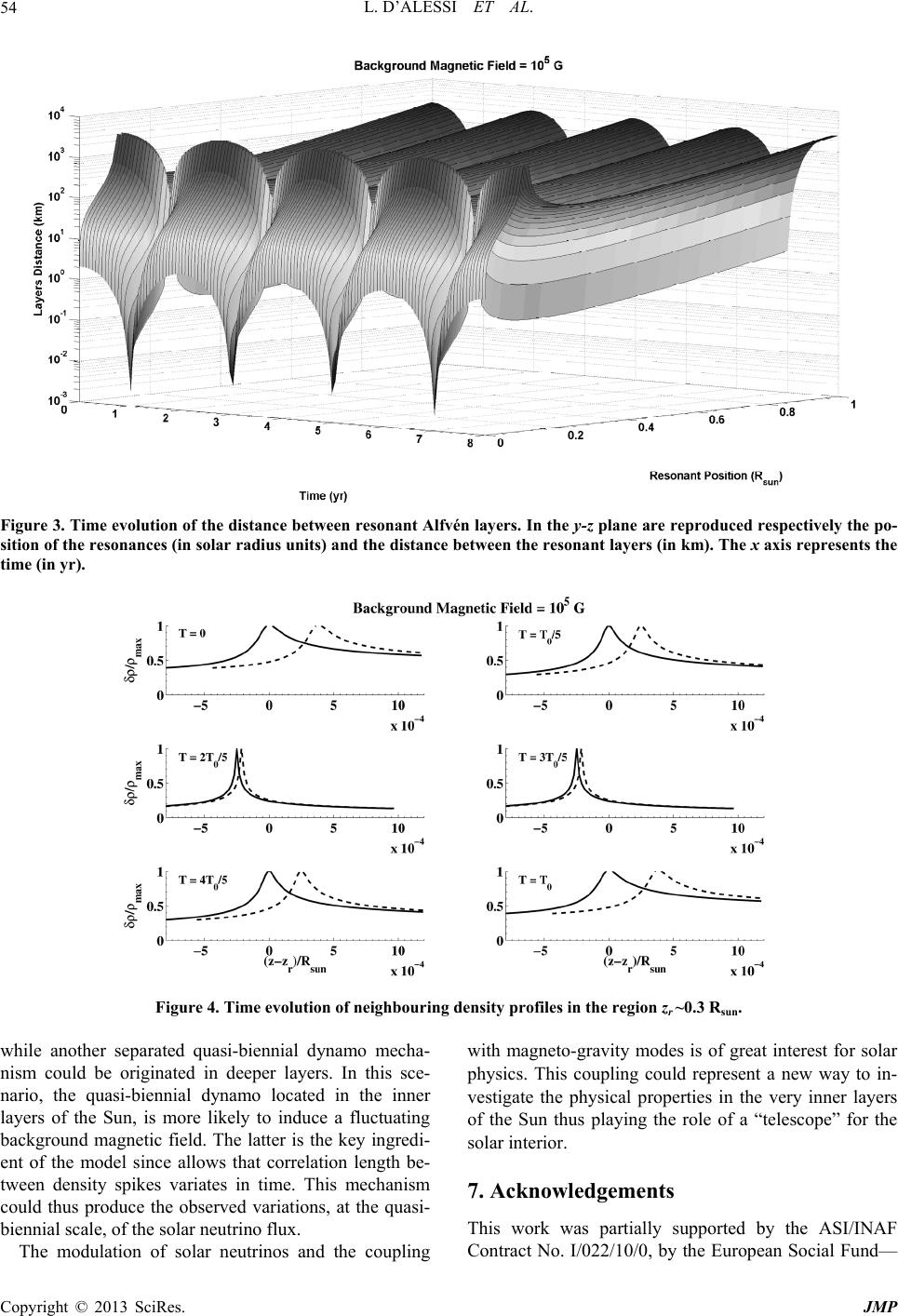 L. D’ALESSI ET AL. Copyright © 2013 SciRes. JMP 54 Figure 3. Time evolution of the distance between resonant Alfvén layers. In the y-z plane are reproduced respectively the po- sition of the resonances (in solar radius units) and the distance between the resonant layers (in km). The x axis represents the time (in yr). Figure 4. Time evolution of neighbouring density profiles in the region zr ~0.3 Rsun. while another separated quasi-biennial dynamo mecha- nism could be originated in deeper layers. In this sce- nario, the quasi-biennial dynamo located in the inner layers of the Sun, is more likely to induce a fluctuating background magnetic field. The latter is the key ingredi- ent of the model since allows that correlation length be- tween density spikes variates in time. This mechanism could thus produce the observed variations, at the quasi- biennial scale, of the solar neutrino flux. with magneto-gravity modes is of great interest for solar physics. This coupling could represent a new way to in- vestigate the physical properties in the very inner layers of the Sun thus playing the role of a “telescope” for the solar interior. 7. Acknowledgements This work was partially supported by the ASI/INAF Contract No. I/022/10/0, by the European Social Fund— The modulation of solar neutrinos and the coupling 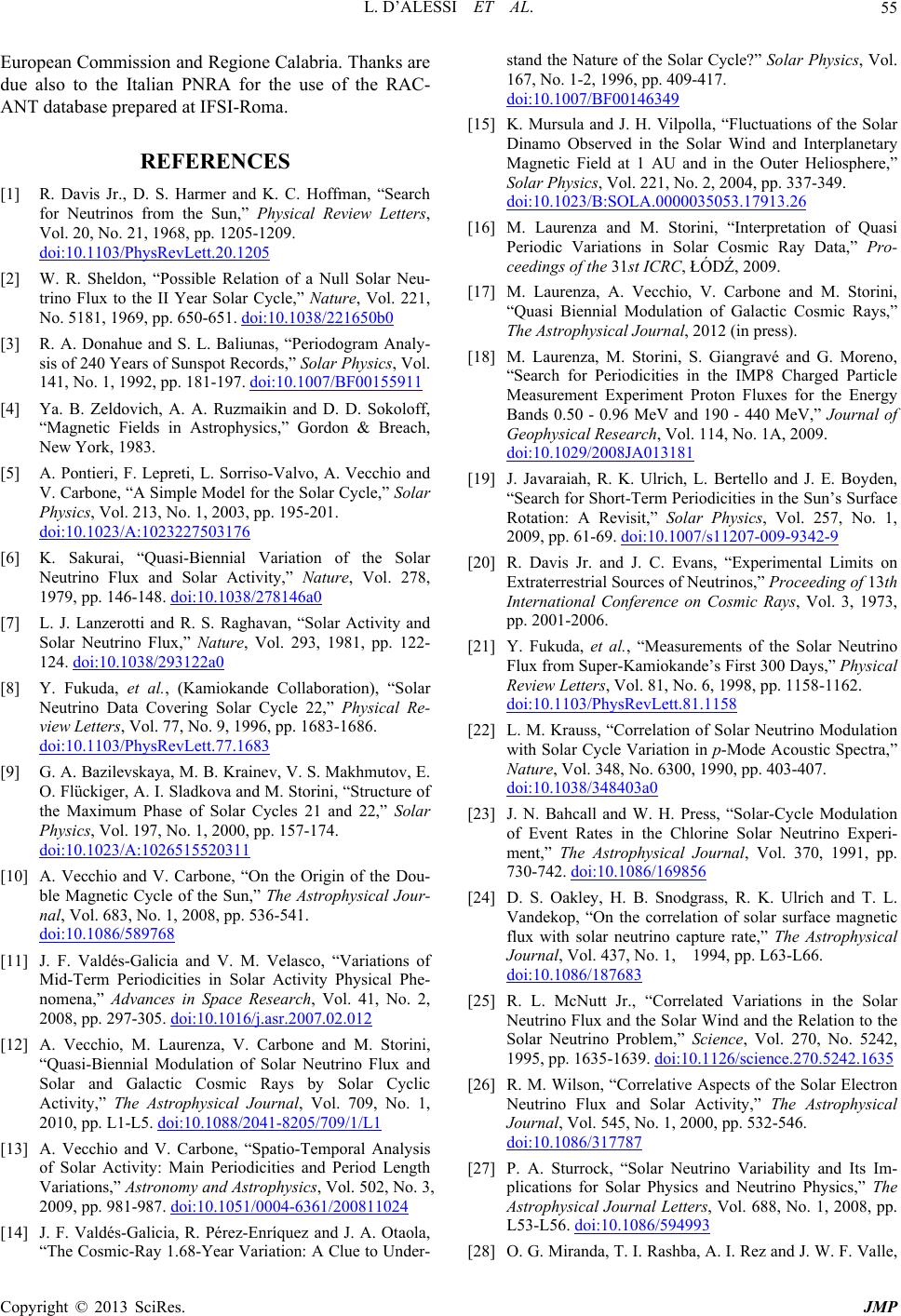 L. D’ALESSI ET AL. 55 European Commission and Regione Calabria. Thanks are due also to the Italian PNRA for the use of the RAC- ANT database prepared at IFSI-Roma. REFERENCES [1] R. Davis Jr., D. S. Harmer and K. C. Hoffman, “Search for Neutrinos from the Sun,” Physical Review Letters, Vol. 20, No. 21, 1968, pp. 1205-1209. doi:10.1103/PhysRevLett.20.1205 [2] W. R. Sheldon, “Possible Relation of a Null Solar Neu- trino Flux to the II Year Solar Cycle,” Nature, Vol. 221, No. 5181, 1969, pp. 650-651. doi:10.1038/221650b0 [3] R. A. Donahue and S. L. Baliunas, “Periodogram Analy- sis of 240 Years of Sunspot Records,” Solar Physics, Vol. 141, No. 1, 1992, pp. 181-197. doi:10.1007/BF00155911 [4] Ya. B. Zeldovich, A. A. Ruzmaikin and D. D. Sokoloff, “Magnetic Fields in Astrophysics,” Gordon & Breach, New York, 1983. [5] A. Pontieri, F. Lepreti, L. Sorriso-Valvo, A. Vecchio and V. Carbone, “A Simple Model for the Solar Cycle,” Solar Physics, Vol. 213, No. 1, 2003, pp. 195-201. doi:10.1023/A:1023227503176 [6] K. Sakurai, “Quasi-Biennial Variation of the Solar Neutrino Flux and Solar Activity,” Nature, Vol. 278, 1979, pp. 146-148. doi:10.1038/278146a0 [7] L. J. Lanzerotti and R. S. Raghavan, “Solar Activity and Solar Neutrino Flux,” Nature, Vol. 293, 1981, pp. 122- 124. doi:10.1038/293122a0 [8] Y. Fukuda, et al., (Kamiokande Collaboration), “Solar Neutrino Data Covering Solar Cycle 22,” Physical Re- view Letters, Vol. 77, No. 9, 1996, pp. 1683-1686. doi:10.1103/PhysRevLett.77.1683 [9] G. A. Bazilevskaya, M. B. Krainev, V. S. Makhmutov, E. O. Flückiger, A. I. Sladkova and M. Storini, “Structure of the Maximum Phase of Solar Cycles 21 and 22,” Solar Physics, Vol. 197, No. 1, 2000, pp. 157-174. doi:10.1023/A:1026515520311 [10] A. Vecchio and V. Carbone, “On the Origin of the Dou- ble Magnetic Cycle of the Sun,” The Astrophysical Jour- nal, Vol. 683, No. 1, 2008, pp. 536-541. doi:10.1086/589768 [11] J. F. Valdés-Galicia and V. M. Velasco, “Variations of Mid-Term Periodicities in Solar Activity Physical Phe- nomena,” Advances in Space Research, Vol. 41, No. 2, 2008, pp. 297-305. doi:10.1016/j.asr.2007.02.012 [12] A. Vecchio, M. Laurenza, V. Carbone and M. Storini, “Quasi-Biennial Modulation of Solar Neutrino Flux and Solar and Galactic Cosmic Rays by Solar Cyclic Activity,” The Astrophysical Journal, Vol. 709, No. 1, 2010, pp. L1-L5. doi:10.1088/2041-8205/709/1/L1 [13] A. Vecchio and V. Carbone, “Spatio-Temporal Analysis of Solar Activity: Main Periodicities and Period Length Variations,” Astronomy and Astrophysics, Vol. 502, No. 3, 2009, pp. 981-987. doi:10.1051/0004-6361/200811024 [14] J. F. Valdés-Galicia, R. Pérez-Enríquez and J. A. Otaola, “The Cosmic-Ray 1.68-Year Variation: A Clue to Under- stand the Nature of the Solar Cycle?” Solar Physics, Vol. 167, No. 1-2, 1996, pp. 409-417. doi:10.1007/BF00146349 [15] K. Mursula and J. H. Vilpolla, “Fluctuations of the Solar Dinamo Observed in the Solar Wind and Interplanetary Magnetic Field at 1 AU and in the Outer Heliosphere,” Solar Physics, Vol. 221, No. 2, 2004, pp. 337-349. doi:10.1023/B:SOLA.0000035053.17913.26 [16] M. Laurenza and M. Storini, “Interpretation of Quasi Periodic Variations in Solar Cosmic Ray Data,” Pro- ceedings of the 31st ICRC, ŁÓDŹ, 2009. [17] M. Laurenza, A. Vecchio, V. Carbone and M. Storini, “Quasi Biennial Modulation of Galactic Cosmic Rays,” The Astrophysical Journal, 2012 (in press). [18] M. Laurenza, M. Storini, S. Giangravé and G. Moreno, “Search for Periodicities in the IMP8 Charged Particle Measurement Experiment Proton Fluxes for the Energy Bands 0.50 - 0.96 MeV and 190 - 440 MeV,” Journal of Geophysical Research, Vol. 114, No. 1A, 2009. doi:10.1029/2008JA013181 [19] J. Javaraiah, R. K. Ulrich, L. Bertello and J. E. Boyden, “Search for Short-Term Periodicities in the Sun’s Surface Rotation: A Revisit,” Solar Physics, Vol. 257, No. 1, 2009, pp. 61-69. doi:10.1007/s11207-009-9342-9 [20] R. Davis Jr. and J. C. Evans, “Experimental Limits on Extraterrestrial Sources of Neutrinos,” Proceeding of 13th International Conference on Cosmic Rays, Vol. 3, 1973, pp. 2001-2006. [21] Y. Fukuda, et al., “Measurements of the Solar Neutrino Flux from Super-Kamiokande’s First 300 Days,” Physical Review Letters, Vol. 81, No. 6, 1998, pp. 1158-1162. doi:10.1103/PhysRevLett.81.1158 [22] L. M. Krauss, “Correlation of Solar Neutrino Modulation with Solar Cycle Variation in p-Mode Acoustic Spectra,” Nature, Vol. 348, No. 6300, 1990, pp. 403-407. doi:10.1038/348403a0 [23] J. N. Bahcall and W. H. Press, “Solar-Cycle Modulation of Event Rates in the Chlorine Solar Neutrino Experi- ment,” The Astrophysical Journal, Vol. 370, 1991, pp. 730-742. doi:10.1086/169856 [24] D. S. Oakley, H. B. Snodgrass, R. K. Ulrich and T. L. Vandekop, “On the correlation of solar surface magnetic flux with solar neutrino capture rate,” The Astrophysical Journal, Vol. 437, No. 1, 1994, pp. L63-L66. doi:10.1086/187683 [25] R. L. McNutt Jr., “Correlated Variations in the Solar Neutrino Flux and the Solar Wind and the Relation to the Solar Neutrino Problem,” Science, Vol. 270, No. 5242, 1995, pp. 1635-1639. doi:10.1126/science.270.5242.1635 [26] R. M. Wilson, “Correlative Aspects of the Solar Electron Neutrino Flux and Solar Activity,” The Astrophysical Journal, Vol. 545, No. 1, 2000, pp. 532-546. doi:10.1086/317787 [27] P. A. Sturrock, “Solar Neutrino Variability and Its Im- plications for Solar Physics and Neutrino Physics,” The Astrophysical Journal Letters, Vol. 688, No. 1, 2008, pp. L53-L56. doi:10.1086/594993 [28] O. G. Miranda, T. I. Rashba, A. I. Rez and J. W. F. Valle, Copyright © 2013 SciRes. JMP  L. D’ALESSI ET AL. Copyright © 2013 SciRes. JMP 56 “Enhanced Solar Antineutrino Flux in Random Magnetic Fields,” Physical Review D, Vol. 70, No. 11, 2004, Arti- cle ID: 113002. doi:10.1103/PhysRevD.70.113002 [29] P. Bamert, C. P. Burgess and D. Michaud, “Neutrino Propagation through Helioseismic Waves,” Nuclear Phy- sics B, Vol. 513, No. 1-2, 1998, pp. 319-342. doi:10.1016/S0550-3213(97)00672-X [30] C. P. Burgess, N. S. Dzhalilov, M. Maltoni, T. I. Rashba, V. B. Semikoz, M. A. Tórtola and J. W. F. Valle, “Large Mixing Angle Oscillations as a Probe of the Deep Solar Interior,” The Astrophysical Journal Letters, Vol. 588, No. 1, 2003, pp. L65-L68. doi:10.1086/375482 [31] C. P. Burgess, N. S. Dzhalilov, T. I. Rashba, V. B. Semikoz and J. W. F. Valle, “Resonant Origin for Density Fluctuations Deep within the Sun: Helioseismology and Magneto-Gravity Waves,” Monthly Notices of the Royal Astronomical Society, Vol. 348, No. 2, 2004, pp. 609-624. doi:10.1111/j.1365-2966.2004.07392.x [32] A. Vecchio, L. D’Alessi, V. Carbone, M. Laurenza and M. Storini, “The Empirical Mode Decomposition to Study the Quasi-Biennial Modulation of Solar Magnetic Activ- ity and Solar Neutrino Flux,” Advances in Adaptive Data Analysis, Vol. 4, No. 1-2, 2012, Article ID: 1250014. doi:10.1142/S1793536912500148 [33] L. D’Alessi, A. Vecchio, M. Laurenza, M. Storini and V. Carbone, “Solar Neutrino Flux Modulated by Solar Activity,” Proceeding of the International School of Physics “E. fermi”, Vol. 182: Neutrino Physics and As- trophysics, IOS Press, Amsterdam, 2012, pp. 349-351. [34] R. Davis, Private Communications, 2004. [35] J. N. Abdurashitov, et al., (SAGE Collaboration), “Meas- urement of the Solar Neutrino Capture Rate with Gallium Metal. III. Results for the 2002-2007 Data Tacking Period,” Physical Review C, Vol. 80, No. 1, 2009, Article ID: 015807, pp. 1-16. doi:10.1103/PhysRevC.80.015807 [36] N. E. Huang, Z. Shen, S. R. Long, M. C. Wu, H. H. Shih, Q. Zheng, N. C. Yen, C. C. Tung and H. H. Liu, “The Empirical Mode Decomposition and the Hilbert Spectrum for Nonlinear and Non-Stationary Time Series Analysis,” Proceedings of the Royal Society A, Vol. 454, 1998, pp. 903-995. doi:10.1098/rspa.1998.0193 [37] D. A. T. Cummings, R. A. Irizarry, N. E. Huang, T. P. Endy, A. Nisalak, K. Ungchusak and D. S. Burke, “Trav- elling Waves in the Occurence of Dengue Haemorrhagic Fever in Thailand,” Nature, Vol. 427, 2004, pp. 344-347. doi:10.1038/nature02225 [38] J. Terradas, R. Oliver and J. L. Ballester, “Application of Statistical Techniques to the Analysis of Solar Coronal Oscillations,” The Astrophysical Journal, Vol. 614, No. 1, 2004, pp. 435-447. doi:10.1086/423332 [39] D. M. Simpson, A. F. C. Infantosi and D. A. Botero- Rosas, “Estimation and Significance Testing of Cross- Correlation between Cerebral Blood Flow Velocity and Background Electro-Encephalograph Activity in Signals with Missing Samples,” Medical and Biological Engi- neering and Computing, Vol. 39, No. 4, 2001, pp. 428- 433. doi:10.1007/BF02345364 [40] S. T. Fletcher, A. M. Broomhall, D. Salabert, S. Basu, W. J. Chaplin, Y. Elsworth, R. A. Garcia and R. New, “A Seismic Signature of a Second Dinamo?” The Astrophysi- cal Journal Letters, Vol. 718, No. 1, 2010, pp. L19-L22. doi:10.1088/2041-8205/718/1/L19
|